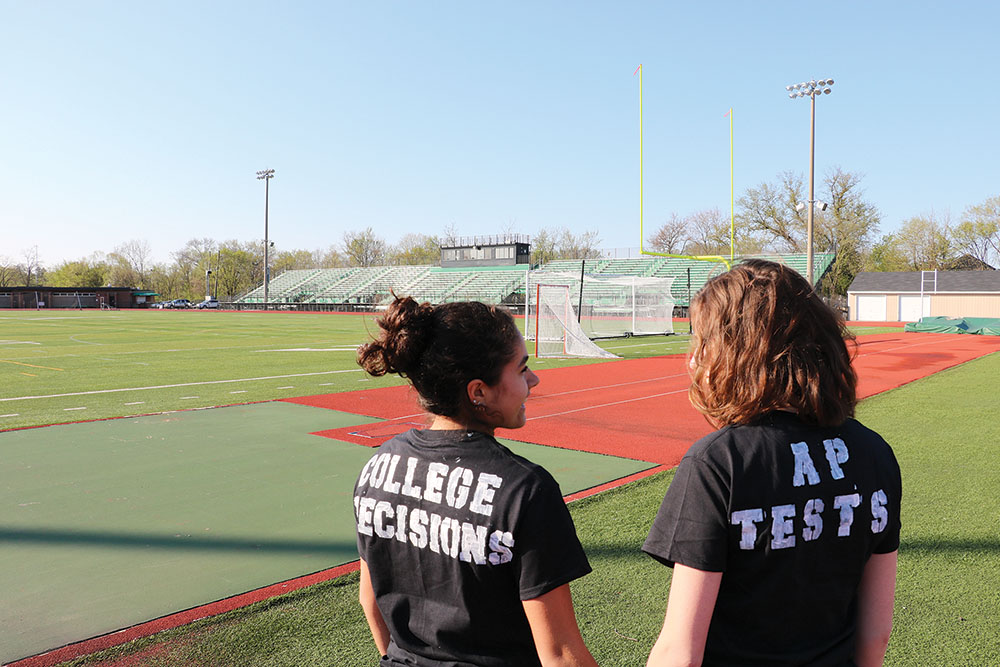Continuing the conversation: how do we talk about mental health?
May 9, 2019
During the full-staff story idea session for our spring issue, over a fifth of our reporters pitched stories on mental health. In a class of students with a wide variety of interests, it was surprising to us that so many students were on the same wavelength.
But it’s not just students in our class; students all throughout York have this topic at the forefront of their brains. This mindset is in sync with teens all over America who are grappling with mental health as well as the overwhelming stress of living in the digital age of Instagram and Snapchat. Because of how much teenage culture has shifted due to our continued turn to social media, the TV and movies we consume are now often focused on storylines that bring the dangers of this new lifestyle to light.
For example, many current York students remember when Netflix released the first season of “13 Reasons Why” in 2017, prompting a conversation about the ways in which we deal with and represent mental health. Some mental health professionals were critical to the popular show’s approach, especially due to some of the graphic and triggering content.
“Some mental health experts say the show could pose health risks for certain young people, such as those who have suicidal thoughts,” CNN Health & Wellness Feature Writer Jacqueline Howard said. “Others suggest the show provides a valuable opportunity to discuss suicide risk with young people, as well as teaching them how to identify warning signs of depression or suicidal thoughts among their peers.”
In a brand new study released by the American Academy of Child and Adolescent Psychiatry this April 29 that followed teen suicide rates in the wake of the TV show’s premiere on March 31, 2017, they found that there was an alarming spike in teen suicide rates: “the overall suicide rate among 10- to 17-year-olds increased significantly in the month immediately following the release of 13 Reasons Why.”

Seniors Sidney Valdez and Jacki Riek.
This alarming statistic brings up how the series sensationalized and glamorized very serious health issues, which Features Editor Sarah Pinkowski talks about in her piece “Mental illness is not glamorous” on page 8.
“Characters in TV shows and movies with mental illnesses almost never convey the severity of it to its full extent and their disorders is often used as alluring characteristic rather than a disorder,” Pinkowski said.
Although the way the popular show handled the material is increasingly debatable, especially given the alarming studies that are still being released, it opened up a conversation between teens, as well as adults with teens, about suicide, mental health and the importance of having these discussions about mental well-being with teens in an increasingly pressure-filled world.
Beyond “13 Reasons Why,” the media has continued to start conversations about self identity between family, friends and in the classroom, such as the 2018 romantic comedy “Love Simon” that portrayed a young teen’s romance as he comes out. In addition, popular TV shows like “This is Us” and “Black-ish” include inclusive storylines that represent a greater look at the human experience.
This trend is not limited to TV and movies, as it has also continued onstage with shows like the Tony Award-winning “Dear Evan Hansen.” The musical, which premiered on Broadway in 2016, centers around a high school boy with a diagnosed social anxiety disorder. York has a unique connection to this show, Benj Pasek and Justin Paul having visited the drama department in 2014. Throughout the run of the show, creators and cast have received an overwhelming amount of feedback from fans speaking to how the show has given them hope and inspired them to reach out for help.
“The shows songs and its indelible characters hit home for some of the millions of Americans with mental health issues, as well as the experts and advocates working to break down barriers to mental health treatment, including stigma, fear and shame,” TIME reporter Kate Reilly said in an article about the show’s impact on teens.
In addition, the show has partnered with non-for-profit organizations including the Child Mind Institute, Crisis Text Line, the Jed Foundation, the Trevor Project, and Born this way foundation to raise money and support the organizations that support teens like the teens in their show.
This diversifying of traditional media includes a portrayal of a more rounded American teenager specifically, forgoing traditional ideas of sexuality and gender roles. In Managing Editor Grace Moriarty’s article on page 9, titled “Man up… or not”, she looks at how boys have been misportrayed in typical American media, and how this has affected their health and identity.
“The societal expectations for men to deal with their issues on their own rather than seeking help, getting medication, or talking with a therapist is damaging,” Moriarty writes.
In this issue of York-hi, we discuss the importance of communication, as well as various elements of mental health and the teen experience, and how it’s being dealt with at York. On page 6, Cece Lampa and Paige Szipszky share their research and interviews with specific students who have faced mental health challenges throughout high school and how York has supported these individuals. No matter what the experience, the importance of communication is highlighted.
“People don’t realize how many people have mental health issues,” one of the interviewees from their article said. “I tend to be pretty vocal about it, and I think people mainly know that I have something going on. But there are a lot of people who don’t necessarily know, and it can make people scared. It can make people uncomfortable when talking about it.”
CeCe and Paige’s article focuses on the hospitalization process and how York handles students with these needs, but this is only one group of people. The reality is that there are many students who need help and counseling, and although we could not highlight these people specifically, we acknowledge the many facets of a complicated discussion.

For seniors Jojo Moyer and Holly Goodwin, their stressors were “public speaking” and “planning”.
We chose to put students on the front cover because we wanted to address the reality that students all throughout York are dealing with a variety of stresses and pressures that contribute to their overall mental health and wellbeing. In fact, according to a study done by the Journal of the American Academy of Child and Adolescent Psychiatry, “One in five young people suffer from a mental illness.” Each of the shirts feature a word or phrase that was created by each student to specifically describe what was a stressor for them at this moment in their high school careers.
May is Mental Health Awareness Month, and as high school journalists, as well as students and peers, it’s our job to continue this conversation and not just look at the cases we mention here but the wide variety of mental health concerns that we weren’t able address in these 28 pages. As a staff, we support how the district has created mental health initiatives, and as a newspaper we will continue to follow their progress and communicate the many complex sides to this relevant and important topic. As long as we continue to communicate and let mental health be a priority, we can only continue to move forward in the pursuit of a more aware and compassionate world for teens.

